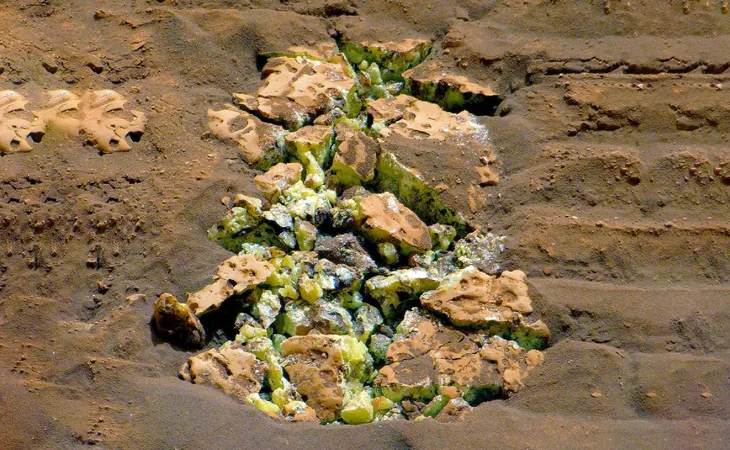
Curiosity Rover Unearths Sulfur Surprises on Mars: Could This Be Evidence of Past Life?
2025-03-25
Author: Ying
On May 30, 2024, NASA's Curiosity rover made an astonishing find on the Martian surface that could revolutionize our understanding of the planet's history and the possibility of life beyond Earth. While traversing an area rich in sulfate minerals, the rover unexpectedly struck a rock, which cracked open to unveil a remarkable array of bright yellow sulfur crystals. This striking discovery has captivated scientists and rekindled discussions about the potential for life on Mars.
Project scientist Ashwin Vasavada from NASA's Jet Propulsion Laboratory expressed his astonishment: “Discovering a field of stones made of pure sulfur is like finding an oasis in the desert. It shouldn’t be there, so now we have to explain it.” This find is particularly significant because, while sulfates have been detected in the past, they were typically part of mineral mixtures rather than in their pure elemental form. The implications of finding such elemental sulfur are profound, as they hint at specialized environmental conditions that haven’t previously been associated with this region of the Red Planet.
The role of sulfur extends beyond mere geological interest; it is also a crucial element in defining the potential for life. On Earth, certain microorganisms thrive on sulfur compounds, relying on them for energy. The presence of sulfur on Mars—especially in combination with evidence of water—raises questions about ancient habitats conducive to life. The discovery of pure sulfur indicates that chemical environments could have existed which supported microbial ecosystems.
Curiosity has been exploring the layered geological formations of Mount Sharp for over seven years, allowing scientists to piece together the planet's climatic and environmental history. Each layer examined reveals insights into ancient river systems, lake beds, and shifting climates. This specific region, known as Gediz Vallis, is of great interest because it shows signs of being shaped by water-driven events that may have contributed to the present landscape.
The rover's mission is far from over. On June 18, Curiosity created its 41st borehole at a site dubbed "Mammoth Lakes", where scientists aim to analyze the soil for additional sulfur compounds and other elements that may further illuminate Mars' chemical history. Understanding these processes and the soil's composition could provide evidence not only of past environmental conditions but also of the faint fingerprints of any microbial life that may have existed.
As Curiosity continues its exploration, the excitement among scientists grows about the potential discoveries that lie ahead. Each sample, every new layer of rock, holds the promise of new insights into the storied past of Mars, and whether this ancient world ever mirrored the conditions necessary for life to emerge.
While the discovery of sulfur alone does not confirm that life once existed on Mars, it certainly strengthens the case for its potential presence. With scientists eagerly analyzing Curiosity's findings, the debate over life on Mars continues to gain momentum, enticing both the scientific community and the general public alike.
Stay tuned for more groundbreaking revelations from Mars, as Curiosity rolls on, unraveling the mysteries of our celestial neighbor and sparking imaginations about what else may be out there in the universe!


 Brasil (PT)
Brasil (PT)
 Canada (EN)
Canada (EN)
 Chile (ES)
Chile (ES)
 Česko (CS)
Česko (CS)
 대한민국 (KO)
대한민국 (KO)
 España (ES)
España (ES)
 France (FR)
France (FR)
 Hong Kong (EN)
Hong Kong (EN)
 Italia (IT)
Italia (IT)
 日本 (JA)
日本 (JA)
 Magyarország (HU)
Magyarország (HU)
 Norge (NO)
Norge (NO)
 Polska (PL)
Polska (PL)
 Schweiz (DE)
Schweiz (DE)
 Singapore (EN)
Singapore (EN)
 Sverige (SV)
Sverige (SV)
 Suomi (FI)
Suomi (FI)
 Türkiye (TR)
Türkiye (TR)
 الإمارات العربية المتحدة (AR)
الإمارات العربية المتحدة (AR)